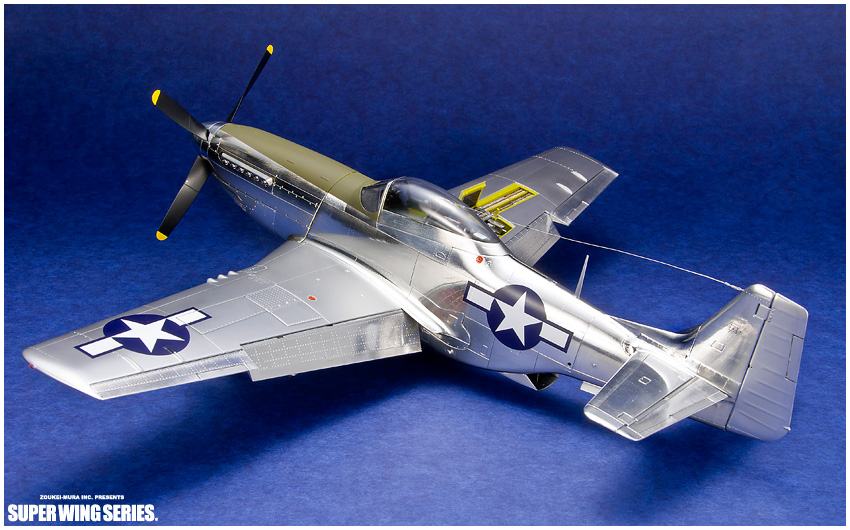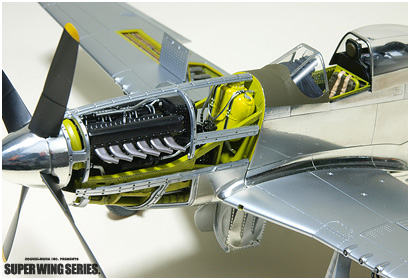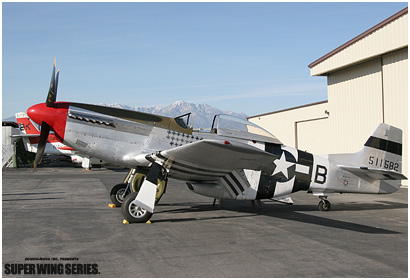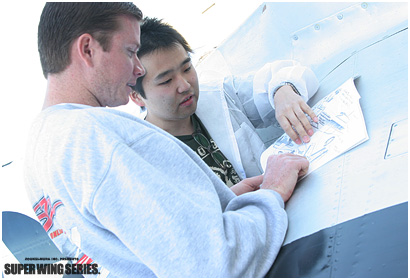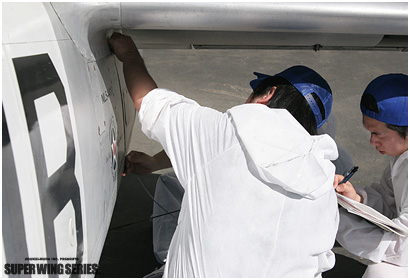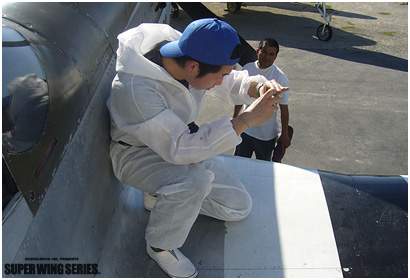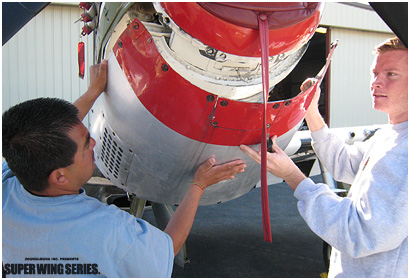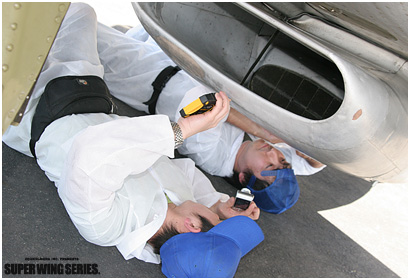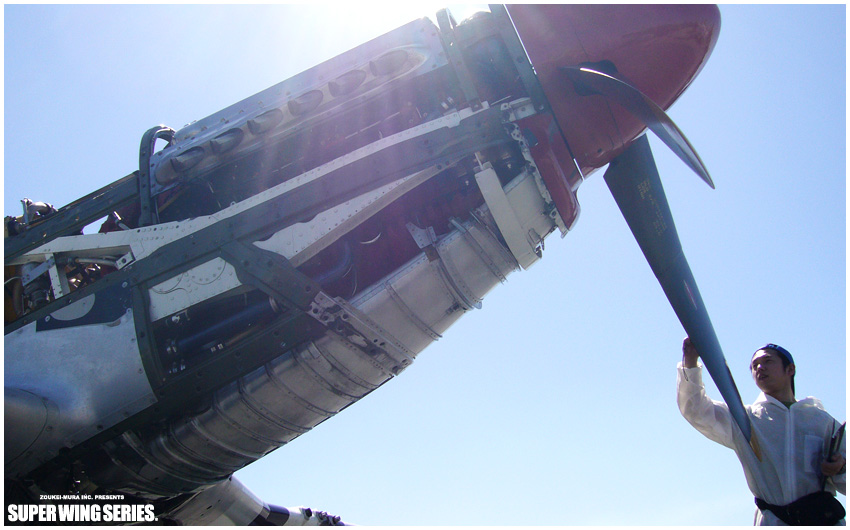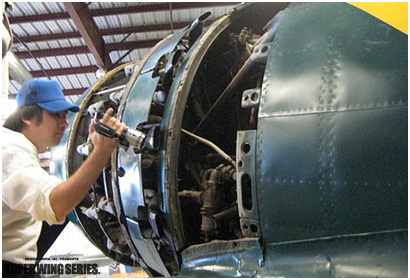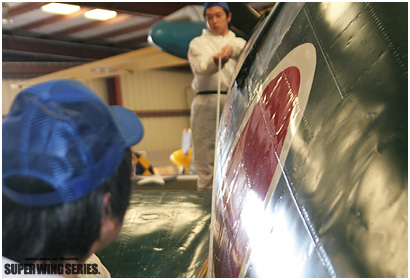We harvested something unexpected as well.We were also allowed to research the Raiden (Mitsubishi J2M, Thunderbolt) at Chino. That was truly unexpected. We were lucky enough to get a chance to see inside as they generously opened the panels, which had never been opened since the aircraft was moved from Japan. 
|
I will show you more details of the SWS P-51D kit along with photos which we have all long awaited in my next blog post here. Of course, let me also introduce to you the aircraft which we announced at the Nuremburg Toy Fair with photos to vividly recreate the atmosphere of the event site. I think that's good for today. Be careful not to catch a cold! Take care! Please look forward to my next post!!
Hideyuki Shigeta |
|
|
If you have any opinions, questions, or requests regarding the SWS, please don't hesitate to let us know. 
|
Archives: The Old Man Blog
- The Old Man Blog No.134Enjoy the best part of SWS kit with the instruction manual. Imperial Japanese Navy fighter aircraft SHINDEN: Episode 2
- The Old Man Blog No.133Enjoy the best part of SWS kit with the instruction manual. Imperial Japanese Navy fighter aircraft SHINDEN: Episode 1
- The Old Man Blog No.132Enjoy the best part of SWS kit with the instruction manual. Focke-Wulf Fw 190 A-4 Siegfried Schnell: Last Episode (Final Outfitting)
- The Old Man Blog No.131Enjoy the best part of SWS kit with the instruction manual. Focke-Wulf Fw 190 A-4 Siegfried Schnell: Episode 4 (Assembling main wings and fuselage, engine mounting and main landing gear)
- The Old Man Blog No.130Enjoy the best part of SWS kit with the instruction manual. Focke-Wulf Fw 190 A-4 Siegfried Schnell: Episode 3 (Fuselage Assembly)
- The Old Man Blog No.129Enjoy the best part of SWS kit with the instruction manual. Focke-Wulf Fw 190 A-4 Siegfried Schnell: Episode 2 (Cockpit)
- The Old Man Blog No.128Enjoy the best part of SWS kit with the instruction manual. Focke-Wulf Fw 190 A-4 Siegfried Schnell: Episode 1 (Engine)
- The Old Man Blog No.127For the first time in three years! Zoukei-Mura participated in IPMS Texas San Marcos in the U.S.!
- The Old Man Blog No.126Enjoy the best part of SWS kit with the instruction manual Part 3: HEINKEL He 219 A-0 Uhu Last Part
- The Old Man Blog No.125Enjoy the best part of SWS kit with the instruction manual Part 3: HEINKEL He 219 A-0 Uhu 2nd
- The Old Man Blog No.124Enjoy the best part of SWS kit with the instruction manual Part 3: HEINKEL He 219 A-0 Uhu
- The Old Man Blog No.123Enjoy the best part of SWS kit with the instruction manual Part 2: Lats Part
- The Old Man Blog No.122Enjoy the best part of SWS kit with the instruction manual Part 2: 2nd
- The Old Man Blog No.121Enjoy the best part of SWS kit with the instruction manual Part 2
- The Old Man Blog No.120The instruction manual for the SWS 1/32 "Bf 109 G-14/U14" is completed!! Part 5
- The Old Man Blog No.119The instruction manual for the SWS 1/32 "Bf 109 G-14/U14" is completed!! Part 4
- The Old Man Blog No.118The instruction manual for the SWS 1/32 "Bf 109 G-14/U14" is completed!! Part 3
- The Old Man Blog No.117The instruction manual for the SWS 1/32 "Bf 109 G-14/U14" is completed!! Part 2
- The Old Man Blog No.116The instruction manual (Japanese version) for the SWS 1/32 "Bf 109 G-14/U14" is completed!! Part 1
- The Old Man Blog No.115Thank you very much for the pre-orders from all over the world!!!
- The Old Man Blog No.114With Engines Roaring!!
- The Old Man Blog No.113Celebrating the 10th Anniversary of SWS!! Thank you for supporting our 35 releases!!
- The Old Man Blog No.112I Hope You’re Doing Well, My SWS Brothers!!!
- The Old Man Blog No.111Your Pre-Ordered Limited-Edition F-4EJ Kai "Phantom Forever 2020" Kit is Coming to You Soon!!
- The Old Man Blog No.110SWS F-4EJ Kai "Phantom Forever 2020" is SOLD OUT via Pre-Order!!! Thank you for all of your pre-orders!!
- The Old Man Blog No.1091/48 F-4EJ Kai Celebrating 10 Years of SWS Thank you all for your early pre-orders!!
- The Old Man Blog No.10810th Anniversary of SWS Kits: The First Commemorative Kit Revealed!!
- The Old Man Blog No.107What's up, SWS fans?!?
- The Old Man Blog No.106We Went to SMC in Telford!!
- The Old Man Blog No.105Let’s Meet at SMW in Telford!!
- The Old Man Blog No.104We’re back from IPMS Nationals in Chattanooga!!!
- The Old Man Blog No.103A Big Hello to All of My SWS Brothers!!
- The Old Man Blog No.102Welcome to the Zoukei-Mura Booth at IPMS Telford! Thank you for purchasing the 1/32 Toryu!!
- The Old Man Blog No.101We went to IPMS Phoenix!! Plus an Exciting Quiz: Guess the Next SWS Airplane!!
- The Old Man Blog No.100Have you got F-4J Marines?
- The Old Man Blog No.099The long-awaited F-4 D, finally available from February 17th (Sat)!!
- The Old Man Blog No.098SWS Brothers from UK & Europe!! Thank you very much!!
- The Old Man Blog No.097The autumn show of hobby world is about to begin!!
- The Old Man Blog No.096We've been here!! Wings Over the Rockies Air & Space Museum!!!
- The Old Man Blog No.095 We went to IPMS Nationals in Omaha!! (Part 2)
- The Old Man Blog No.094 We went to IPMS Nationals in Omaha!! (Part 1)
- The Old Man Blog No.093 Already the beginning of summer?!! But while I was silent, the new release of the F-4S got closer!!
- The Old Man Blog No.092 Happy New Year 2017!
- The Old Man Blog No.091 Greetings for the end of 2016
- The Old Man Blog No.090 Thanks for the instant sell-out!
- The Old Man Blog No.089 SWS F-4J finally ready for its pre-release at the IPMS Telford!!
- The Old Man Blog No.088 The Giant of the Jet-fighters F-4: the Answer from Zoukei-mura - Part 4
- The Old Man Blog No.087 The Giant of the Jet-fighters F-4: the Answer from Zoukei-mura - Part 3
- The Old Man Blog No.086 The Giant of the Jet-fighters F-4: the Answer from Zoukei-mura - Part 2
- The Old Man Blog No.085 The Giant of the Jet-fighters F-4: the Answer from Zoukei-mura - Part 1
- The Old Man Blog No.084 We went to the IPMS Columbia!!
- The Old Man Blog No.083 Hey! Just like I said!! With the SWS kit, you can understand this far the Do 335's secrets!
- The Old Man Blog No.082 SWS Do 335 Thank you for all the reservations we received from all over the world!!
- The Old Man Blog No.081 So, let's build the Do 335!! Last Episode.
- The Old Man Blog No.080 So, let's build the Do 335!! Episode No.5: "this time let me introduce you the work on the main wings!!"
- The Old Man Blog No.079 So, let's build the Do 335!! Episode No.4: "this time I introduce you the work on the main wings!!"
- The Old Man Blog No.078 So, let's build the Do 335!! Episode No.3: "the cockpit is awesome too".
- The Old Man Blog No.077 So, let's build the Do 335!! Episode No.2: "how to build the DB 603 engine".
- The Old Man Blog No.076 So, let's build the Do 335!!
- The Old Man Blog No.075 The soul of a reciprocating engine is finally here!!
- The Old Man Blog No.074 IPMS Telford 2015 Event Report: Episode 3
- The Old Man Blog No.073 IPMS Telford 2015 Event Report: Episode 2
- The Old Man Blog No.072 IPMS Telford 2015 Event Report: Episode 1
- The Old Man Blog No.071 The Old Man's meddling!!
- The Old Man Blog No.070 Here we go!! IPMS Telford 2015 is about to start!!!
- The Old Man Blog No.069 We went to the IPMS Nationals in Ohio!!!
- The Old Man Blog No.068 Come, SWS brothers!
- The Old Man Blog No.067 What is the rear taste of building a kit?
- The Old Man Blog No.066 One of the plastic model kits' tastes (the current taste)
- The Old Man Blog No.065 Spring time! Hobby season has come!!
- The Old Man Blog No.064 Thank you for the pictures of your finished SWS kits!
- The Old Man Blog No.063 Presentation of the finished SWS Horten kit!! 2nd Part!!
- The Old Man Blog No.062 Presentation of the finished SWS Horten kit!!
- The Old Man Blog No.061 The indispensable tools of the Old Man!
- The Old Man Blog No.060 Urgent Notice for all of you who purchased our SWS 1/32 Horten kit!
- The Old Man Blog No.059 IPMS Telford 2014 Event Report: Episode 1
- The Old Man Blog No.058 SWS Horten finally spreads its wing and flies in to the big sky!
- The Old Man Blog No.057 IPMS Virginia 2014 Event Report: Episode 4
- The Old Man Blog No.056 IPMS Virginia 2014 Event Report: Episode 3
- The Old Man Blog No.055 IPMS Virginia 2014 Event Report: Episode 2
- The Old Man Blog No.054 IPMS Virginia 2014 Event Report: Episode 1
- The Old Man Blog No.053 Zoukei-Mura finally headed to IPMS Virginia!
- The Old Man Blog No.052 Development status for SWS HORTEN Kit Part2
- The Old Man Blog No.051 Development status for SWS HORTEN Kit Part1
- The Old Man Blog No.050 Want to see more of HORTEN!!
- The Old Man Blog No.049 The first test shot of SWS Ho 229 is finally getting here!!
- The Old Man Blog No.048 Welcome to JOINT FESTIVAL of our company that will celebrate the 40th Anniversary of Volks Inc!!
- The Old Man Blog No.047 IPMS Telford 2013 Event Report
- The Old Man Blog No.046 IPMS Colorado 2013 Event Report 3
- The Old Man Blog No.045 IPMS Colorado 2013 Event Report 2
- The Old Man Blog No.044 IPMS Colorado 2013 Event Report 1
- The Old Man Blog No.043 The so long-awaited Japanese aircraft episode is starting
- The Old Man Blog No.042 Finally, the long-awaited SWS kit, "He 219 Uhu," has started shipping, in order by reservation!
- The Old Man Blog No.041 The final production prototype for SWS No. 6 Uhu is done
- The Old Man Blog No.040 Cockpit Assembly
- The Old Man Blog No.039 We went this year, as well!! The Nurnberg Toy Fair in Germany!!
- The Old Man Blog No.038 For all of our SWS fans and Uhu fans, I have an apology and an announcement!
- The Old Man Blog No.037 IPMS Telford 2012 Event Report: Part3
- The Old Man Blog No.036 IPMS Telford 2012 Event Report: Part2
- The Old Man Blog No.035 IPMS Telford 2012 Event Report: Part1
- The Old Man Blog No.034 The Opening Day of IPMS Telford is Finally Getting Closer!!
- The Old Man Blog No.033 Event Report from IPMS Florida 2012, Final Part
- The Old Man Blog No.032 Event Report from IPMS Florida 2012, Part2
- The Old Man Blog No.031 Event Report from IPMS Florida 2012, Part1
- The Old Man Blog No.030 Delivering Your Hopes along with My Dreams
- The Old Man Blog No.029 Finally, the SWS Mustang will Take Flight!!!
- The Old Man Blog No.028 The Pre-Order Deadline for the P-51D Mustang is Coming Soon!
- The Old Man Blog No.027 SWS Mustang! Long-Awaited Pre-Order Period Finally Started!!
- The Old Man Blog No.026 Delivering the SWS Mustang to All of You Around the World!!
- The Old Man Blog No.025 I Want to Make the Most Beautiful Mustang through the SWS!!
- The Old Man Blog No.024 Event Report from IPMS in Telford, UK #4
- The Old Man Blog No.023 Event Report from IPMS in Telford, UK #3
- The Old Man Blog No.022 Event Report from IPMS in Telford, UK #2
- The Old Man Blog No.021 Event Report from IPMS in Telford, UK #1
- The Old Man Blog No.020 Is Your SKYRAIDER Already Home?!
- The Old Man Blog No.019 Thank You for Waiting!! Your SKYRAIDER is Finally Coming Home!!
- The Old Man Blog No.018 Took a Trip!! To IPMS "Omaha By The Sea"!!! Part 3
- The Old Man Blog No.017 Took a Trip!! To IPMS "Omaha By The Sea"!!! Part 2
- The Old Man Blog No.016 Took a Trip!! To IPMS "Omaha By The Sea"!!! Part 1
- The Old Man Blog No.015 Package design has reached its final stage!!
- The Old Man Blog No.014 The 'R3350 Engine' and the 'Cockpit' are complete!!
- The Old Man Blog No.013 Japan and the Japanese will recover, once again!!
- The Old Man Blog No.012 SKYRAIDER Test Model 1 Debut, Part 2!!
- The Old Man Blog No.011 The SWS SKYRAIDER will fly over the sky of Nurnberg!
- The Old Man Blog No.010 Is Your Ta 152 Being Brought Up Happily!!??
- The Old Man Blog No.009 The time that Ta 152 fans worldwide have been waiting and waiting for has finally arrived.
- The Old Man Blog No.008 Finally, it's just before the release of the Ta 152!! At last it goes to you!!
- The Old Man Blog No.007 Scale Model Reproduction Must Start with Your Gut Feeling! Is What I've Really Come to Believe.
- The Old Man Blog No.006 Ta 152 Means Wings!!
- The Old Man Blog No.005 Forgive Me, Brothers-in-Arms! At This Point, Just Let Me Announce It~!!!
- The Old Man Blog No.004 Also,The Engine Known As Jumo 213E Is Amazing!!
- The Old Man Blog No.003 This Ta 152 H-1 is Amazing!!
- The Old Man Blog No.002 Using plastic, that magicalmaterial,I wont to create a real airplane!
- The Old Man Blog No.001 Passion for the Product Launch Process

